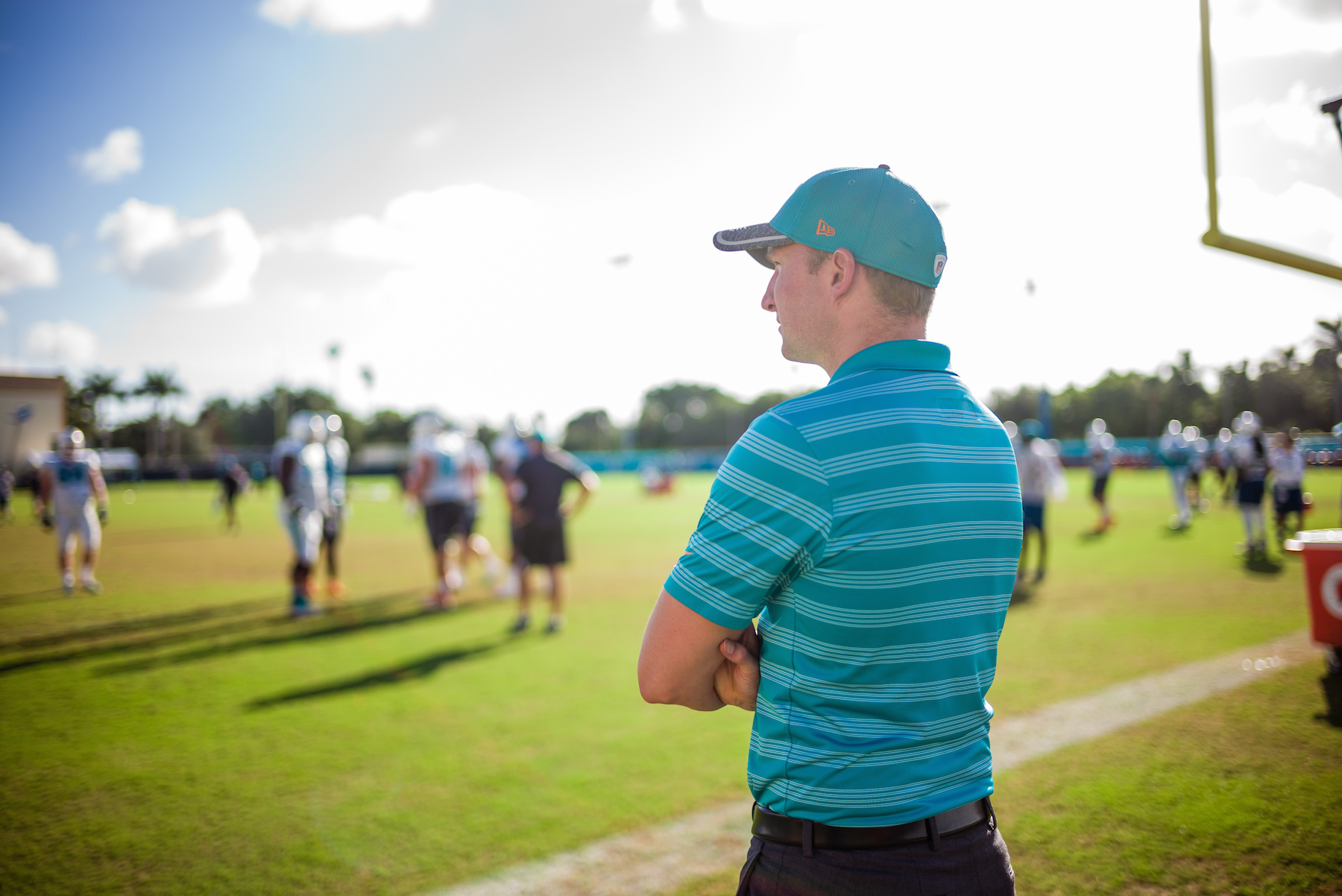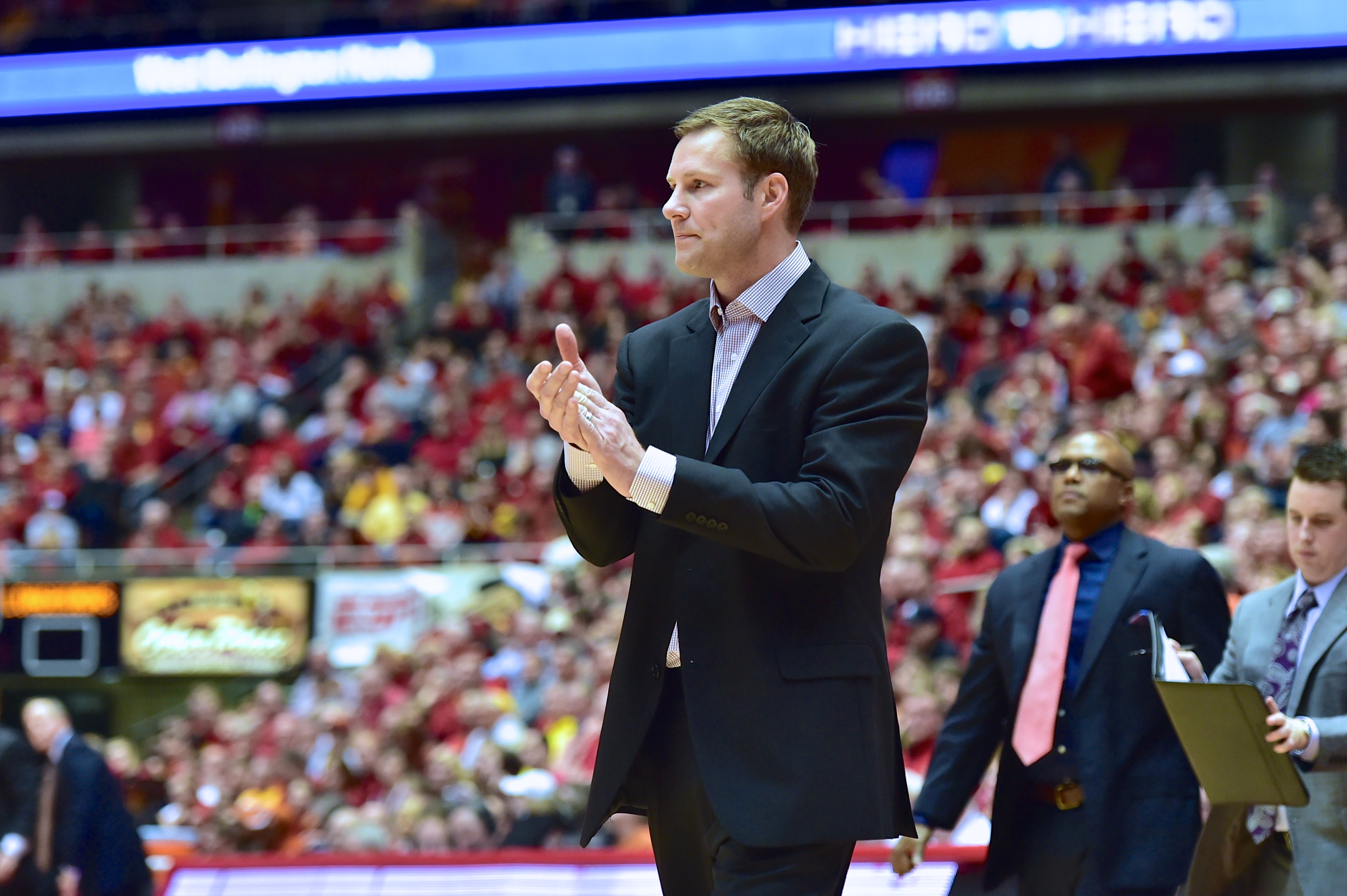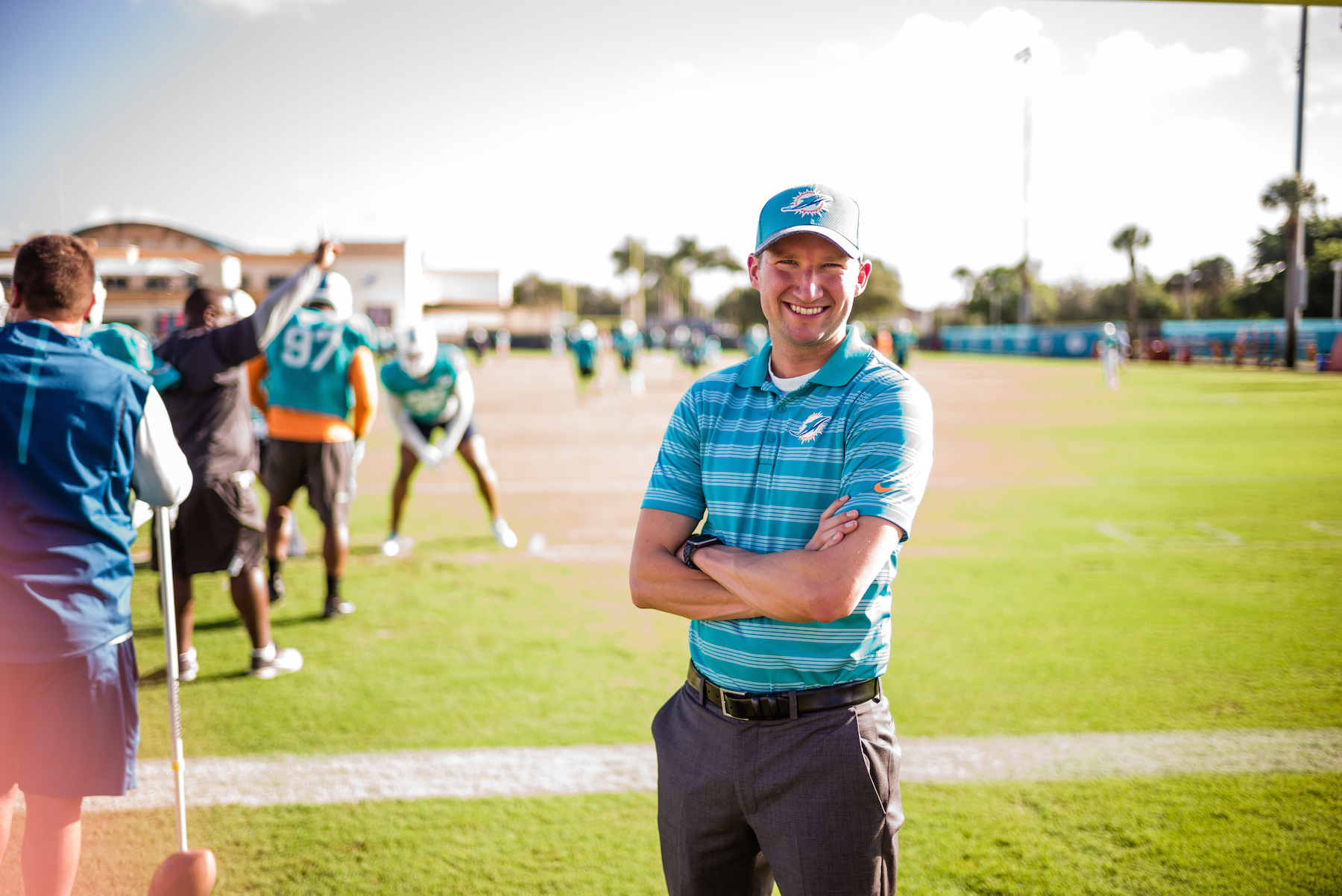If you watch the Miami Dolphins this season and hear their quarterback yell “Dennis! Dennis! Dennis!” on a play call, you should feel a little Iowa State pride.
“Dennis” is Dennis Lock (’11 M.S., ’16 Ph.D. statistics), now in his fourth season as director of analytics for the Dolphins. He is responsible for bringing a data-driven perspective to player performance, player personnel and coaching analysis, and even suggesting the occasional play.
The National Football League (NFL) is a rookie in data science, Lock said, trailing behind Major League Baseball, the National Basketball Association and the National Hockey League. But the Dolphins, who made the playoffs last season for the first time since 2008, are changing that. When Lock was recruited to build their first analytics division from scratch, it was like his own personal draft day for his dream job.
“My wife, Amy (’13 Ph.D. statistics), says I need a new goal now because I accomplished my goal before I was 30,” Lock joked.
An all-star background in numbers
Growing up, Lock played hockey and soccer and, like a lot of young kids, dreamed of the pros.
“I found out from a pretty young age I wasn’t going to make it into professional sports by playing sports,” Lock said.
Then he read the Michael Lewis classic, “Moneyball,” a story of how the Oakland Athletics produced a winning team built with data, and envisioned a new route to his dream.
“I found out from a pretty young age I wasn’t going to make it into professional sports by playing sports.”
While Lock may not have been a draft-pick athlete, he has an all-star background in numbers. Both his parents have a Ph.D. in mathematics and teach statistics at St. Lawrence University in New York, while both his siblings have a Ph.D. in statistics and are faculty at Penn State University and the University of Minnesota. The family even teamed up to write a statistics textbook together, co-authored by Lock, Lock, Lock, Lock and – you guessed it – Lock.
While researching hockey as an undergraduate at St. Lawrence University, Lock worked with Dr. Michael Schuckers (’99 Ph.D. statistics), who told him about Iowa State’s graduate program.
“It was a no-brainer that was where I belonged,” Lock said. “You’ve got the Division I sports, a fantastic statistics department, connections here and there.”
A game-changing graduate school experience

It sounded like a winning game plan: a sports fanatic with a strong mathematical background gets accepted into a top statistics program at a Division I school. There was just one potential problem. Could Lock find a professor willing to take on a graduate student to do a full dissertation in sports statistics?
“It’s almost unheard of,” Lock said.
Dan Nettleton, Distinguished Professor of Statistics and the Laurence H. Baker Chair in Biological Statistics, was not only willing, but he also shared Lock’s passion for sports, publishing his first paper in 1998 on home-court advantage in Big Ten basketball.
“In a way sports initiated my interest in data and analysis and probability,” Nettleton said, recalling how as a child he simulated games based on baseball and football card statistics.
Nettleton, a developer of statistical methods for studying genes in plant and animal systems, was intrigued by the idea of using a dozen years of NFL play-by-play data, with more than half a million data points, to predict win probabilities with "random forest" methodology.
The goal was to answer this type of question: in an NFL game, second down and ten, you are down by three at midfield with five minutes left. What are the odds you win the game?
Lock and Nettleton started with the quality of the two teams competing, using the Las Vegas point spread as a reliable indicator of each team’s strength. If one team was favored by three points, for example, then they pulled previous games with a three-point favorite. Then they looked at the score. If it was 17 to 14 with five minutes to go, they found past games with a similar game scenario. Then they examined where the ball was on the field. And on and on deeper into the data.
“What the random forest does is help us filter through to find – out of all those half a million data points – which ones are most like the current circumstances,” Nettleton said. "The random forest is good at using the data to automatically determine the important variables in a given circumstance and then finding past cases that are like the current scenario. Once we have a collection of situations from the past that are like the current situation, we can ask, ‘how often did the team with the ball go on to win the game?’”
"Once we have a collection of situations from the past that are like the current situation, we can ask, ‘how often did the team with the ball go on to win the game?’”
In 2017, Nettleton, who also advises ISU’s Sports Analytics Club, received Iowa State’s Margaret Ellen White Graduate Faculty Award, which recognizes major professors who enrich the student-professor relationship. It is easy to see why.
“The willingness Dan had to try a completely different field separate from his own research interests was huge for me,” Lock said. “It allowed me to pursue my dream all throughout graduate school. I will always be thankful for that.”
Learning with a legend
In professional sports, research only matters if it can be effectively communicated to a coaching staff. At Iowa State, Lock practiced those skills with a Cyclone legend.

“I remember the first time I met Coach (Fred) Hoiberg,” Lock said. “I was nervous because he’s such a legend around here. To be in there talking basketball with him, I got the butterflies in my stomach. Years later, meeting Dan Marino for the first time, I wasn’t nearly as nervous as that first time meeting Coach Hoiberg.”
As a graduate volunteer, Lock scraped the Cyclone men’s basketball play-by-play data off the internet, analyzing lineups and possession trends, and then occasionally presented his reports in person to coaches. His proudest analysis showed how points per possession went up whenever former Iowa State guard Monte Morris was on the floor as a freshman.
“I remember the first time I met Coach (Fred) Hoiberg,” Lock said. “I was nervous because he’s such a legend around here. To be in there talking basketball with him, I got the butterflies in my stomach. Years later, meeting Dan Marino for the first time, I wasn’t nearly as nervous as that first time meeting Coach Hoiberg.”
“There are a lot of people who can do a lot of incredible analyses, but actually presenting them in a way that the coach can take and understand and utilize in the game plan that week is extremely challenging,” Lock said. “It was very valuable to me to get that initial experience as a volunteer in graduate school.”
A team approach for success
Today, Lock uses R statistical software and an SQL database manager to manage the growing Dolphins data set he relies on throughout the NFL Scouting Combine, the NFL Draft, the 16-game season and all practices. Each move players make in practice is measured at 40 times per second via GPS and accelerometers in their shoulder pads. Likewise, every movement in games is tracked using RFID technology.

Since his first season, Lock has refined his approach in an NFL culture not accustomed to using data analysis. A mention of “random forest methodology” might get you laughed out of a meeting. But showing how a specific strategy could yield an extra half-win per season?
“That was a lightbulb moment with a coach going, ‘There might be something to this analytics thing,’” he said. “And once we had that breakthrough, we went on to share all these other ways we could help and the relationship formed.”
Like football, sports analytics requires a team approach for success.
“Analytics is in no way in competition with traditional scouting or coaching,” he said. “It’s all a symbiotic relationship.”
For example, during the draft Lock researches college players based on their basic and advanced statistics and evaluates every prospect. He gets a voice in the room just like a regular scout – only he speaks from a data-driven perspective.
“Analytics is in no way in competition with traditional scouting or coaching,” he said. “It’s all a symbiotic relationship.”
“I consider it checks and balances in a lot of ways,” he said. “In my ideal world, if all the scouts like a player and all my models and data come back saying, ‘I don’t think he’s actually going to be that good’—if [the scouts] go back and watch more tape on the player, re-evaluate and still really like the player and we draft him, that’s completely okay. I’m happy in that situation. My role is to just make sure they have the information before making each decision.”
One of the first players he pushed for was Jay Ajayi, a running back who had a breakout season last year as the fourth player in NFL history to rush for 200 or more yards in three games in the same season.
“I love the high pressure, high intensity moments, and I love seeing my work impact these moments,” Lock said. “Draft Day is my favorite, keeping track of all these trades going on at once, seeing all these players we spent all this time evaluating actually join teams, especially our selections. Every selection is a culmination of so much work from so many talented people, and knowing what went into them and how I impacted those selections on Draft Day is something I love.”
“I love the high pressure, high intensity moments, and I love seeing my work impact these moments.”
Data with an impact
NFL data analytics is young and will only grow, Lock said, citing professional sports teams that have even hired general managers and coaches with analytics backgrounds.
“The data is becoming more extreme and so much more robust, almost to the point where it’s going to become a computer science position as much as it is a statistics position,” he said.
On game day though, the job is surprisingly simple. Lock becomes a regular Dolphins fan, no data necessary.
“We’re part of building this game plan all week and you get to see that game plan come out on the field on Sunday,” he said. “I love seeing how the work our department has done helps the team on game day. There will be certain ideas we came up with, and when they work it’s a great feeling.”
